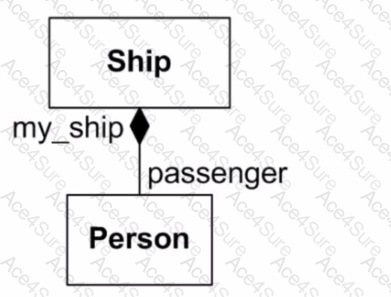In UML, a filled diamond represents a composite aggregation, also known as a composition. It indicates a whole-part relationship with strong ownership and coincident lifetime of the parts with the whole. Here's what it means in relation to the options provided:
A. This is partially correct. A filled diamond indeed indicates that the Ship instance is responsible for the existence of the associated Person instances, but it is not complete as it does not explicitly state that the Person instances will be deleted when the Ship instance is deleted.
B. This option is the most accurate. A filled diamond represents a composite aggregation, which means that the existence of the Person instances (parts) isdependent on the Ship instance (whole). When the Ship instance is deleted, so are the Person instances it contains.
C. The filled diamond is not a placebo; it has a well-defined meaning in UML, indicating strong ownership and lifecycle dependency between the whole and the part.
D. While the filled diamond does indicate ownership, it specifies more than just an attribute relationship; it indicates that the Ship class has a composition relationship with the Person class. This means that the Ship object contains Person objects as parts of itself, not just as an attribute reference.
E. The filled diamond is connected to the Ship class, not the Person class, so this statement is incorrect. The composition relationship is from Ship to Person, not the other way around.
Based on the UML specification for composite aggregation, the most accurate statement isB: Class Person's existence depends on the ship. It will get deleted when the ship gets deleted. This aligns with the definition of composite aggregation, where the part's lifecycle is dependent on the whole's lifecycle.

